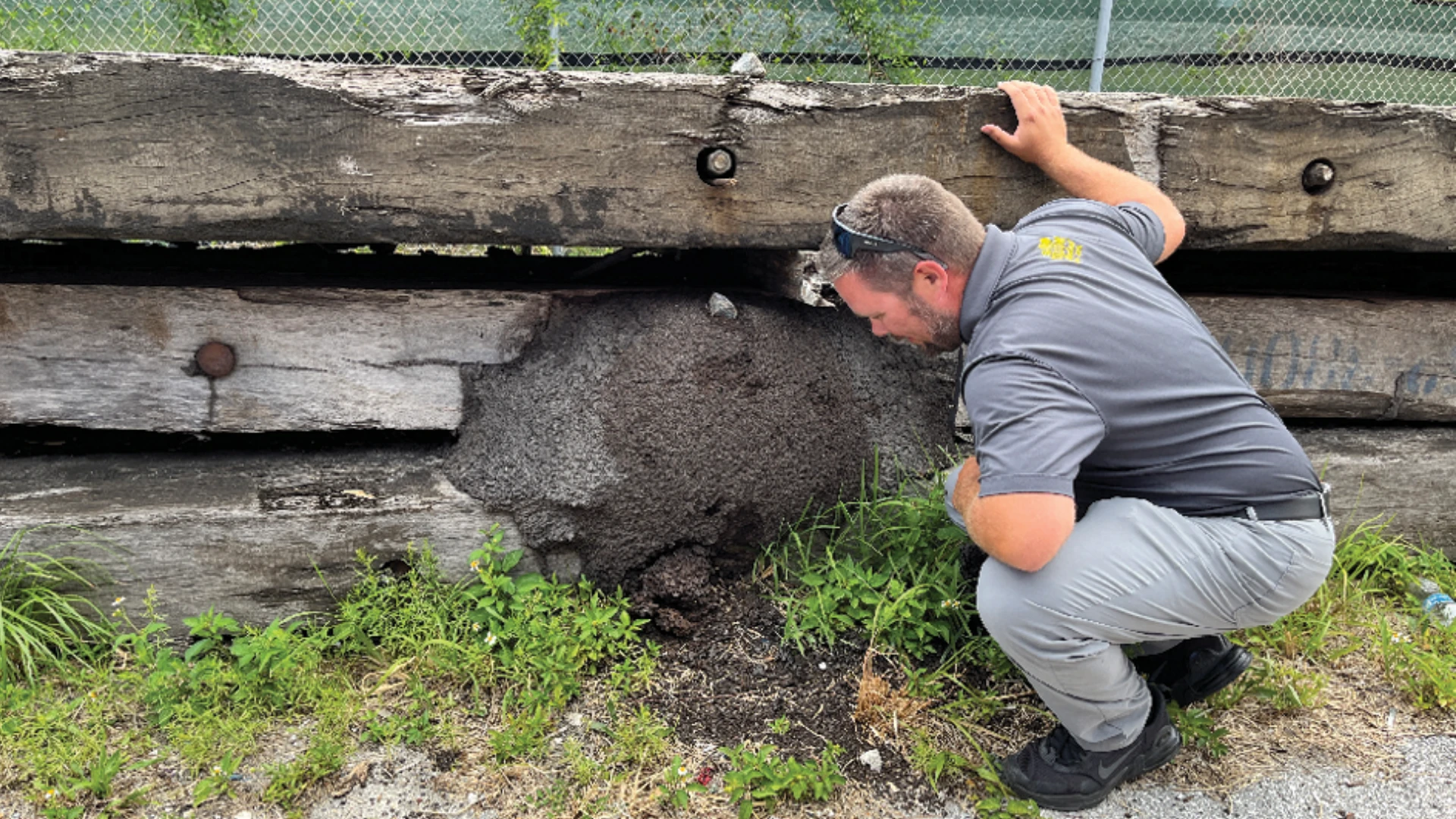A recent study reveals that German cockroach population reduction can be accomplished despite the level of sanitation in an apartment, although when customers cooperate, reduction occurs much faster.
From March 1998 through January 1999, American Pest Management, Takoma Park, Md., evaluated four methods of reducing the risk of acute asthma attacks in inner-city housing occupants who are exposed to cockroach allergens. Apartments were monitored for German cockroaches and, as necessary, treated with Maxforce Cockroach Gel Bait containing hydramethylnon. This reduced-risk pest management strategy minimized the exposure of children to pesticides in the home environment and eliminated, to the maximum extent possible, one of the major sources of asthmatic antigens (German cockroaches).
Apartment housing suspected of having an active German cockroach infestation in most units and a reasonable expectation of cooperation was selected for the project. The majority of occupants were Hispanic and there were typically one to four people per apartment. Most of the apartments were designed as efficiencies, i.e., living room, kitchen, bathroom and large storage room next to the bathroom, typically used as a closet or additional sleeping space.
The apartment floors were wood parquet, except one that had wall-to-wall carpeting. The bathroom and kitchen floors were ceramic and vinyl tiles, respectively. Kitchen cabinets were metal or wood and there were many holes and cracks around the cabinets and n the walls to offer cockroaches abundant harborage. Heating was a hot water/radiator system. Several apartments had window air conditioners.
First Procedure. Thirty-eight apartments were surveyed (in a four-story building of 112 units) for German cockroaches by placing three sticky monitors (one behind the refrigerator, kitchen base cabinet and kitchen wall cabinet) in each unit. An inspection and collection of monitoring data was made 48 hours after monitors were placed. Criteria used to determine suitability for participation included:
• Live cockroaches and/or presence of cockroach droppings;
• Apartment size: either an efficiency, 1- or 2-bedroom;
• Absence of wall-to-wall carpeting;
• State of housekeeping, rated one to five (bad to excellent); and
• Perceived cooperation of tenant.
Second Procedure. Thirty-two apartments were selected for participation in the study. Eight apartments were placed in each of the following categories:
• Group A: baiting, cleaning and education;
• Group B: baiting and education;
• Group C: baiting only; and
• Group D: self-help baiting and education.
During the initial inspection, an English or Hispanic information sheet was left in each apartment indicating that monitors were placed and that the tenant would have an opportunity to participate in a pest management program.
Prior to initiating baiting and cleaning, swab and dust samples for cockroach antigen detection and quantification were collected from all the apartments included in the study.
• Four swab samples (kitchen and living room floors, kitchen base cabinet and living room wall) were taken using a cotton swab moistened with phosphate buffered saline. The sample area was about 4 inches by 4 inches. Samples were tested using a polyclonal antibody detection system.
• Two vacuum cleaner (kitchen floor and living room floor) samples (1 square meter area) were taken from each apartment and the samples were tested using a monoclonal antibody detection system.
Tenants in the apartments identified for cleaning removed all items from the kitchen cabinets and the kitchen area. The cabinets, areas behind the stove and refrigerator and the floors were cleaned using a variety of cleaning materials. Cleaning materials included 409 All-Purpose Cleaner for greasy surfaces; Clorox Clean-Up for counters, walls and cabinets; and a 10 percent bleach solution for floors. Cleaning of the eight units was repeated monthly.
Swab and dust samples were collected from the eight apartments in Group A after the initial cleaning and every 90 days until the study’s completion.
A professional bilingual educator was employed to provide counseling on the purpose of the project, the importance of sanitation and cockroach control and procedures for self-help baiting. At the time of the face-to-face session, tenants were provided an English or Hispanic fact sheet that discussed the importance of cockroach control and the occupant’s role in the process.
Each month all apartments in the study were visually inspected for cockroaches and housekeeping was evaluated. In addition to the visual inspection and housekeeping rating, at 90-day intervals sticky monitors, were placed out 24 hours prior to the service day and counts were made at the time of service.
Results. Cockroach data was collected during 10 consecutive months beginning in March 1998. The results of the sticky trap monitoring (GRM), visual inspections (GRV) and housekeeping ratings (HK) were recorded.
After the first 90 days, the most notable reductions in cockroach populations were achieved in Group A (baiting, cleaning and education) and B (baiting and education) apartments, 94 percent and 98 percent, respectively. The reductions in the Group C (baiting only) and D (self-help baiting and education) apartments were significantly less at 68 percent and 45 percent, respectively. At the conclusion of the study (300 days) the percent reduction in the cockroach populations in Group A to D apartments were 98 percent, 99 percent, 57 percent and 95 percent, respectively.
The initial average housekeeping ratings for Groups A to D apartments were 3.125, 3.0, 3.0 and 3.0, respectively. At the conclusion of the study the average housekeeping ratings for Group A to D apartments were 3.0, 2.43, 2.57 and 1.83, respectively.
The greatest amount of German cockroach debris (GCRD) extract as measured by polyclonal (swab) cockroach antigen tests (competitive inhibition ELISA) were detected consistently in the kitchen cabinets. There was significant variability in the GCRD values for the other sampling sites, i.e., kitchen floor, living room floor and living room wall, however the amount of detectable GCRD was significantly lower in these areas when compared to the kitchen cabinets, which had the greatest amount of German cockroach activity and debris. The pre- and post-cleaning samples also indicated a reduction in the amount of GCRD as the result of cleaning activity. This was most notable in the kitchen cabinet site.
There were slight differences between the four treatments as measured by monoclonal antigen tests (vacuum samples). There was a decline in the amount of detectable antigen in most apartments: Group A (range: 60 to 98 percent; mean: 54 percent; median: 94 percent); Group B (range: 6 to 99 percent; mean: 40 percent; median: 98 percent); Group C (range: 69 to 99.9 percent; mean: 85 percent; median: 89 percent); and Group D (range: 20 to 97 percent; mean: 63 percent; median: 66.5 percent). In two apartments, detectable antigen levels increased: one in Group A (117 percent) and one in Group B (100 percent).
Discussion. Tenant attitudes toward German cockroach infestations varied widely from total intolerance to very complacent attitudes, e.g., living with cockroaches is a fact of life. The presence of pesticide products (11 of 38 apartments initially surveyed), such as over-the-counter cockroach sprays and bait stations, indicated that some tenants were concerned about cockroaches and were taking things into their own hands with regard to cockroach control. The most extreme case was a tenant living in one of the most clean apartments who was spraying and applying boric acid by the pound around the baseboards, stove, refrigerator and the base of the kitchen cabinet. (It worked!) It is uncertain how these self-help efforts, e.g., spraying where baits were subsequently applied and unintentionally spraying over the baits in an effort to help us out, may have impacted our baiting program.
The study’s results indicated that German cockroach population reduction can be accomplished with thorough inspection and bait application despite the level of sanitation in the apartment. However, it is important to note that reduction can be accomplished much more rapidly when the customer understands the health implications of cockroaches and their roles.
Groups A (baiting, cleaning and education) and B (baiting and education). The rapid reduction of cockroach populations in these apartments is a reflection of the initial information provided and the higher level of sanitation during the first 90 days of the study. The level of control may have been better maintained if our information exchange continued throughout the study. This would have resulted in less bait being used in these apartments.
Group C (baiting only). These apartments had acceptable levels of control but the lack of tenant concern about the cockroach infestations delayed the process.
Group D (self-help baiting and education). Self-help treatment in these apartments ranged from the bait being misapplied, i.e., spread all over the place like caulking and paste and to none being applied, despite our efforts to encourage tenants to use the bait provided. Thus, German cockroach control in most of the Group D apartments was much slower, indicating that tenant self-help programs require continuous reinforcement and even then can be expected to fall short.
The results of this study indicate that cleaning is the most significant factor in reducing the amount of detectable German cockroach antigens in inner-city apartments. Antigen reduction was also noted in those units where baiting was the main management tool, however, in most cases, in the absence of cleaning, it appeared that the amount of cockroach antigens increased despite the reduction in the population. Unfortunately, cockroach control (and in some cases elimination) does little to reduce the amount of detectable antigen and does not appear to an effective stand-alone strategy in reducing cockroach antigens.
Housekeeping, i.e., sanitation, remained relatively constant throughout the study and was not a significant factor in the long-term management of cockroach populations using baits. Even in those units cleaned by our research group, the sanitation declined between each scheduled cleaning service, i.e., 30 days. Most occupants came to expect the service and did little on their own to maintain the state of cleanliness established at the outset of the study. Thus, it is unlikely that pest management companies can expect to get much cooperation in terms of cleaning from inner-city occupants despite strong encouragement.
The good news is that baits can be effectively used to manage, and in many cases, eliminate German cockroach populations, despite the level of sanitation. The keys to success are refreshment of the bait, numerous placements, regular and frequent inspections and precise baiting of active harborage sites. We feel that our control efforts would have been even better if all contiguous units were concurrently inspected and baited during the study. Baiting is used to control roaches in other parts of the building, but only on an occupant-request basis. Shortly after the conclusion of this study we were called by the management company to treat a recently vacated unit for cockroaches. This unit was heavily infested with German cockroaches and was directly below one of our participating units. The occupants had never requested service in the prior 12 months.
The most significant reductions in GRCD was noted in the kitchen cabinets. Several factors probably contributed to this: the kitchen cabinet was the greatest site of cockroach activity; cockroach harborage was abundant in all areas of the cabinet; the surfaces of the cabinets were relatively easy to clean in comparison to other surfaces which were covered with layers of grease and other food debris; and inner cabinet surfaces were not subject to as much translocation as the floor sites.
It is important to note that the clinical significance of these findings was not assessed in this study. To our knowledge, there were no documented cases of German cockroach allergy in anyone occupying the apartments in this study.
Summary of Project Impact. The findings of this study indicate that pest management companies can effectively manage cockroach populations and potentially improve the health of millions of children affected by cockroach allergens.
Baits were used exclusively in this study and resulted in a significant reduction in the amount of active ingredient applied in each apartment. Liquid insecticides can effectively accomplish the same level of control, however, depending on the product, there may be health concerns about volatile organic components and "inert" ingredients that may affect the health of already compromised individuals.
Aerosols and flushing agents, such as pyrethrin and pyrethrum, were not used in this study due to the risk of contaminating the baits and potential health concerns, e.g., respiratory irritation. Also, some researchers have expressed concern about agitating the cockroaches causing them to scatter and spread their antigens deeper into harborages and throughout the residential unit.
Baiting was successful in reducing or eliminating the cockroach populations despite the lack of significant changes in sanitation levels, however, cockroach elimination alone did not significantly reduce the level of cockroach antigen. While cleaning did not have a significant impact in reducing the cockroach population, it was the critical element in reducing the amount of cockroach antigen in the apartments.
Authors’ note: Special thanks to Gordon Morrison and Ted Shapas of the Clorox Company who provided the bait for this study; the National Foundation for Integrated Pest Management that provided the funding through U.S. Environmental Protection Agency’s Partners for Environmental Stewardship Program (PESP); Peyton A. Eggleston, M.D., professor of pediatrics, and Pearla Vargas, Ph.D., Johns Hopkins University; and M. Christine Anderson, U.S. Food & Drug Administration.
The authors are with American Pest Management, Takoma Park, Md. Richard Kramer can be reached at rkramer@pctonline.com.

Explore the May 2000 Issue
Check out more from this issue and find your next story to read.
Latest from Pest Control Technology
- The Evolving World of Electronic Rodent Monitoring
- Back-to-basics Approach for Cockroach Control
- PPMA Encourages PMPs to Take Part in Termite Awareness Week
- Moneypenny is a Provider of Virtual Receptionists
- Video: Top 10 PCT Photo Contest Finalists
- Massey Services Expands with Southeast Commercial Region
- Pest Management Foundation Announces Kevin J. Burns Scholarship
- How to Identify Clover Mites





